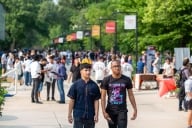You have /5 articles left.
Sign up for a free account or log in.
For all the innovations that are taking place on our campuses, the curriculum remains course-centric.
To be sure, campuses are creating increased opportunities for experiential learning: for study abroad, internships, and service learning opportunities. But with a few notable exceptions–such as Drexel or Northeastern, with their emphasis on coop experiences–the course remains the cornerstone of undergraduate education.
But what if we were to break away from the stand-alone course model. What would be the alternative? What might an undergraduate education look?
My answer: It would be organized around learning experiences. It would be project-based. It would involve “just-in-time” learning. It would embrace the ideal of the student as creator of knowledge.
The first examples are beginning to appear. At the University of Queensland, Phil Long organized a “lean startup,” a workshop in which students work individually or in teams to develop marketable products or services.
At Stanford, more and more students have begun to see college in a new light–as a place to network, acquire essential practical skills and knowledge, and launch a new enterprise.
Traditional departments in the humanities and arts, are increasingly giving way to interdisciplinary clusters, combining technology with the arts or the humanities in ways that are designed to lay the foundation for future start-ups.
At the University of Texas at Dallas, A&T and “EMC”–Arts & Technology and Emerging Media Communications–seek to foster a convergence of computer science and engineering with the creative arts and the humanities.
The expectation is that students will acquire technical skills in animation, interactive narrative and games, virtual environments and sound design. They will also learn about the uses, impact and implications of digital technology for communication, culture and commerce.
The Stanford and UT Dallas examples are not simply add-ons to a traditional curriculum. They are part of a radical reimaging and reinvention of the undergraduate experience.
They merge the innovation processes of artists, scientists and engineers, and explore experimental models through new technologies. Departments are transformed into innovation labs and students into innovators.
Many of our students are too bright and too entrepreneurial to be the recipients of the kind of education acquired in traditional lecture halls, laboratories, or even seminar rooms.
It has become increasingly clear that the mounting diagnoses of Attention Deficit Hyperactivity Disorder in K-12 classrooms is at least partly related to the nature of the student experience: The structure schools impose and the behavioral demands that teachers enforce.
College students are not fundamentally different: They too need opportunities for active and authentic learning, not simply because many learn best by “doing,” but because many need the chance to unleash their creative aspirations.
Steven Mintz is the Executive Director of the University of Texas System’s Institute for Transformational Learning and a Professor of History at the University of Texas at Austin.







